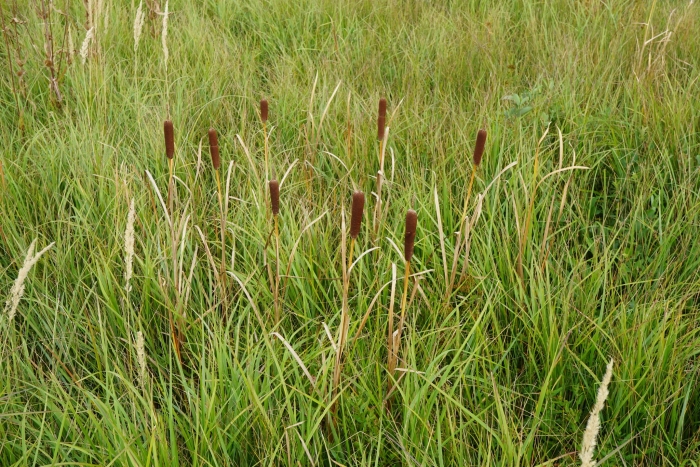Shuttleworth’s Bulrush
(Typha shuttleworthii)
Shuttleworth’s Bulrush (Typha shuttleworthii)
/
/

Patrick Hacker
CC BY 4.0
Image By:
Patrick Hacker
Recorded By:
Copyright:
CC BY 4.0
Copyright Notice:
Photo by: Patrick Hacker | License Type: CC BY 4.0 | License URL: http://creativecommons.org/licenses/by/4.0/ | Rights Holder: Patrick Hacker | Publisher: iNaturalist | Date Created: 2020-09-10T16:19:22-07:00 |

























Estimated Native Range
Summary
Typha shuttleworthii, commonly known as Shuttleworth’s Bulrush, is a perennial herbaceous plant native to wetland habitats such as marshes, fens, and the edges of ponds and lakes in southern Europe to Iran. It is closely related to the broadleaf cattail (T. latifolia) but can be distinguished by its male inflorescence, which is less than half the length of the female inflorescence, shorter anthers, smaller seeds, and narrower leaves. Shuttleworth’s Bulrush typically grows to a height of 4-6 feet (1.2-1.8 meters) and spreads through rhizomes to form dense colonies.
Shuttleworth’s Bulrush is valued for its ecological role in wetland environments, providing habitat and food for wildlife, as well as for its use in phytoremediation to improve water quality. It is also used ornamentally in water gardens and naturalized areas. In cultivation, it requires permanently wet soil and can grow in partial to full sun. While it is not commonly found in the nursery trade, it can be propagated by division or from seed. Gardeners should be aware that it can become invasive if conditions are ideal, spreading aggressively by rhizomes.CC BY-SA 4.0
Shuttleworth’s Bulrush is valued for its ecological role in wetland environments, providing habitat and food for wildlife, as well as for its use in phytoremediation to improve water quality. It is also used ornamentally in water gardens and naturalized areas. In cultivation, it requires permanently wet soil and can grow in partial to full sun. While it is not commonly found in the nursery trade, it can be propagated by division or from seed. Gardeners should be aware that it can become invasive if conditions are ideal, spreading aggressively by rhizomes.CC BY-SA 4.0
Plant Description
- Plant Type: Herb
- Height: 5-7 feet
- Width: 2-3 feet
- Growth Rate: Moderate
- Flower Color: Brown
- Flowering Season: Summer
- Leaf Retention: Deciduous
Growth Requirements
- Sun: Full Sun, Part Shade
- Water: High, Aquatic
- Drainage: Standing
Common Uses
Erosion Control, Water Garden
Natural Habitat
native to wetland habitats such as marshes, fens, and the edges of ponds and lakes in southern Europe to Iran
Other Names
Common Names: Shuttleworth’s Cattail
Scientific Names: , Typha shuttleworthii, Typha bethulona, Typha latifolia subsp. shuttleworthii, Typha latifolia var. bethulona, Typha latifolia var. transsilvanica, Typha orientalis, Typha persica, Typha transsilvanica, Typha ×shuttleworthii,
GBIF Accepted Name: